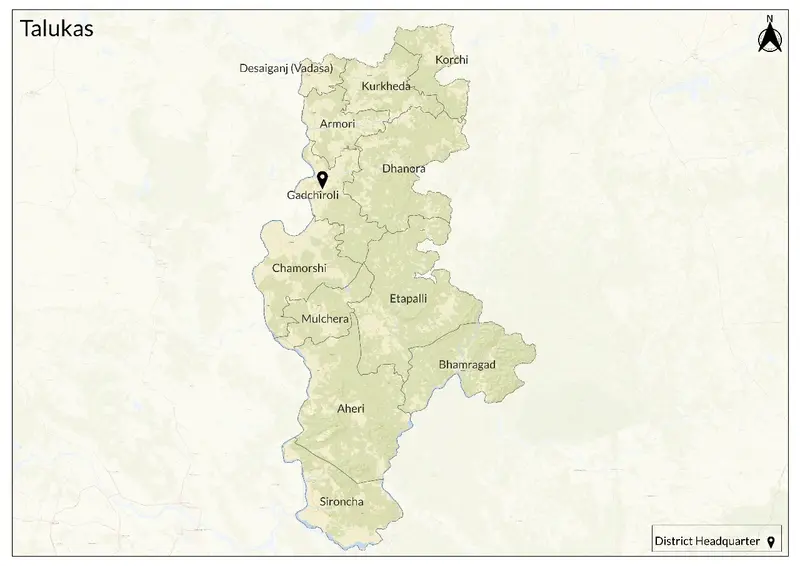Gadchiroli

14,412 sq. km
~ 11,34 lakh (2019)
982 (2011)
~ ₹9,333 crore (2019)
~ ₹82,289 (2019)
Gadchiroli district is located in the southeastern corner of Maharashtra, forming part of the Vidarbha region and bordering Chhattisgarh and Telangana. Established as a separate district on August 26, 1982 (after being split from Chandrapur), the district consists of twelve talukas: Korchi, Kurkheda, Wadsa, Armori, Dhanora, Gadchiroli, Chamorshi, Etapalli, Mulchera, Bhamragarh, Aheri, and Sironcha. The name Gadchiroli is believed to be derived from "Gad" (fort) and "Chiroli" (a village or tree species), though its exact origin remains uncertain. The district is often considered Naxal-infested and is part of the Red Corridor, although Naxal activity has significantly declined in recent years.
Historically, the region was ruled by the Mauryas, Guptas, Rashtrakutas, Chalukyas, Yadavas of Deogiri, and later the Gonds. In the 13th century, Gond king Khandkya Ballal Shah founded Chandrapur (the former capital), and Gadchiroli itself emerged as a tehsil in 1905 under British rule. After a series of administrative changes, including incorporation into the Central Provinces, the district became part of Maharashtra in 1960 and was finally carved out in 1982, with several talukas under its jurisdiction. The district has seen the impact of forest-based industries, and more recently, the Surjagad region has become notable for iron ore mining, which has brought economic changes and community developments since the restart of operations in 2021.
Known as the “lung of Maharashtra,” nearly 70% of the district is covered by forests, representing approximately 21% of the state's total forest area. Major rivers like the Wainganga, Godavari, Indravati, and Pranhita shape the district, while lush landscapes, wildlife sanctuaries, and monsoon greenery make it a region of natural beauty and ecological importance. Indeed, environmentally, Gadchiroli stands out for its extensive forests, hills (Bhamragad, Tipagad, Surjagad), wildlife sanctuaries (Chaprala, Bhamragad), and fossil parks.
Culturally, Gadchiroli is diverse and predominantly tribal. Languages such as Marathi, Gondi, Santali, Telugu, Bengali, and Chhattisgarhi reflect the multi-ethnic population. Among its key religious sites is the Markanda Mahadev Mandir, dedicated to Lord Shiva, located near Chamorshi on the Wainganga River. This temple is a major pilgrimage center, especially during Mahashivaratri and Makar Sankranti festivals. Adivasi festivals like Mohram and Pola are celebrated widely, alongside Bengali festivals such as Durga Puja and Kali Puja, showcasing a blend of indigenous and migrant traditions. The region’s social fabric is interwoven with contributions from healthcare pioneers like Dr. Baba Amte (Lok Biradari Prakalp at Hemalkasa) and researchers Abhay and Rani Bang (reducing infant mortality through SEARCH), both significantly improving local tribal welfare and healthcare.
Agriculture and forestry are the pillars of Gadchiroli’s economy. With more than 2/3rd of its land covered by forests, the district produces teak, bamboo, tendu leaves, paddy, sorghum, linseed, tur, and wheat. While industrial activity is expanding, especially in mining and construction, conservation remains essential for sustaining the district’s environment and indigenous communities. While large-scale industry is limited (centered around paper mills and rice mills), the government has actively promoted industrialisation, particularly through steel and iron ore mining.
